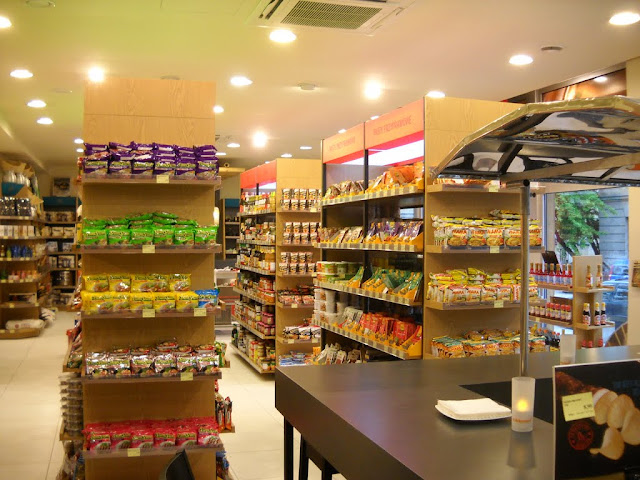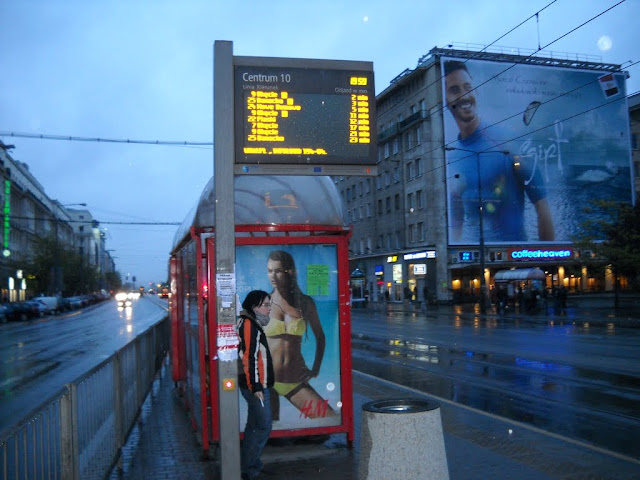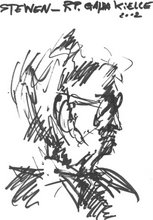It was good to meet you all at the gathering on Saturday. The weather's really too lovely to sit in front of the computer, but I had to check my emails.
My new Canon camera stopped working after about a month, but I took the opportunity of the rare visit to Warsaw to take it in for repair at Fototronic on ul. Żurawia - the entrance is just off Żurawia, in the small side road near Patrick's pub, where the multi-story car park entrance is. The assessment is free and the email came within the promised 3 days. The cost of repair is high (240zl for "unblocking" (zablokowany) the lens), but may be the market rate. However, why pay so much for what seems to be a very low quality product? If only Konica Minolta were still on the market...
After lunch at Maharaja in the Old Town - rice noodles with chicken and sea food, spicy - we popped into Kuchnie Świata at Kilińskiego 3.

This has a good range of Asian food ingredients, although its Asia seems to centre on Thailand, with some extension to Japan, with sadly little outreach to India. The prices didn't seem exorbitant for a specialist shop in an under-supplied market. Indeed, if anything, I felt they were cheaper than the hypermarkets. I bought a large packet of small dried chillies - used for the first time last night, and Panang Curry paste (which doesn't have sugar in it). It looks like it's one of a chain of shops, so you may find one elsewhere. Unfortunately I wasn't allowed to take pictures inside.

Too late. (Hey, it pays to advertise.)
Walking up Długa, the Armed Forces Church door was open and we popped in to look - the first time I've been inside. I didn't go into the main church, for some reason I often feel this is trespassing, but the Katyn memorial is on the right side of the vestibule. The sculpture you immediately meet is impressive, whilst the main part of the memorial is the more striking because of its low key character - the sheer numbers of those killed comes across well. The number was most immediately impressed on me, however, by first seeing a small side plaque listing the names of the military chaplains who were amongst those killed: not a huge number, but just chaplains! Equally interesting is the area on the other side of the church entrance, which contains a lot of small plaques giving soundbites commemorating those who fought and died for Poland. It would be an interesting task for someone just to photograph them all, translate them into English and add a few notes of explanation. For immediate foreign interest there is a plaque for a Liverpool born Polish-Irish woman who decided to become Polish, which always arouses Polish interest. Another commemorates the Polish-Americans who fought in the Polish Army in France during the war, which on asking turned out to be the Second World War.
Meeting you, Paulina, was something I had wanted to do and it was lovely that I had the opportunity. Sorry that I got confused about
whether whether it was your website I thought so much of - my bad memory for names, but it was. Its just that you were completely different from what I had envisaged. You definitely have black hair in your picture and I had envisaged a very tough outspoken woman that I might be slightly scared of saying the wrong thing to. I was completely wrong on both scores. I hope we have the chance to meet again.
I hope to pick up on your - name withheld for some reason I'm not sure of - suggestion of a beer before too long as I have to go back into Warsaw to pick up my useless Canon. I'll give you a call.
I can't remember the wine bar's name and I wasn't impressed enough even to take a couple of minutes to check it. It's in one of the side courtyards off Długa, but the on-street notice stand is easily missed. It has a huge selection of wines ranging in price from 37 to 230zl, whether for drinking or take-away I don't know: it didn't occur to me at the time. I was surprised only to find one champagne, but the bottles of Cava, which are more in my celebration price range, looked interesting - three varieties of one brand. No beer, though. Wandering around the place, it's much larger than its first impression. There was one comfortable looking room right at the back with settees and armchairs - the kids were playing there - and the garden would be nice enough in good weather. (The white wine was cold, by the way. I always feel that I have to ask this, even in Polish Wine Bars.)
Having left, I walked down to Marks and Spencer to buy English strength tea bags: a 240 pack of Extra Strength with 3 grams in each bag. They're the ones with the blue and black Angel perfume style boxes. About 24zl, which at 10 zl per hundred tea bags makes it good value compared with 'quality' tea bags in the shops. Taking account of the tea quantities, the price is equivalent to Tesco's own brand Ceylon tea bags, which I generally use myself. Marks' teabags aren't as good as PG Tips, but Europa Express coaches and hence our routine supplier no longer go to England. Having got tea, I then proceeded to add various discounted treats to the shopping basket. The Extremely Chocolatey White and Dark Chocolate Rounds were much appreciated when I got them back home, not that anyone actually eats chocolate, of course.
Finally down to the tram, but for some reason I overshot and landed in Patrick's, just to say hello for old time's sake. It was one of the earliest of Warsaw's pubs, but the barman (Krzyszek) has been there from 5 days after it opened, which I think means he's been working there 12 years. I first visited it a few weeks later. Why's he still there? A shrug of the shoulders. He's not old. He told me that Michał, his companion barman from those days (when they used to do 24 hour shifts) is still manager for the Russian franchise company after TGI Friday in Janki closed, which was good to hear. I feared he might have been given the sack. As always, just sitting down to a beer, my warning call came, so drink up and go.
At the tram stop, I was reminded of the wonder of Warsaw's Urban transport system.

No not the girl smoking, the barely dressed model or even, depending on your preferences, the handsome man, but the fact that it works. My mind went straight back to waiting for my bus outside Richmond station. I had thought these electronic time checks would be wonderful. I knew that keeping to the timetable was science fiction, but I thought that science could, plus or minus a bit, tell me how far away the bus was. I watched in sheer fascination as the 3 minute wait rose to 5, 10, 15, 25 minutes and then disappeared. OK, maybe the GPS, or whatever, system thinks the bus is here, so wait a few minutes. Nothing, so it's better to walk - I would have been home long ago. However, it was like reading a boring detective story: you want to know who the murderer is and whether you guessed correctly, but you don't want to jump to the end. A few minutes later my next bus appeared on the electronic list, due to arrive in 20 minutes. What would happen? My bus arrived 5 minutes later, whilst the timing on the list still showed 20 minutes. Of course, it's pretty obvious what I did next time. I thought it can't happen twice, didn't I? How do they do that?
Having written all this, I though I wouldn't be able to post it: the system didn't seem to be working, but it has just started. I'm soon going to start feeling guilty for wasting hours of sunshine or floor cleaning time, so mosquitoes are for another day - first bites yesterday.




